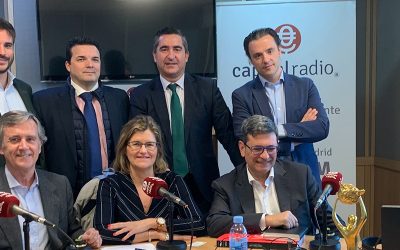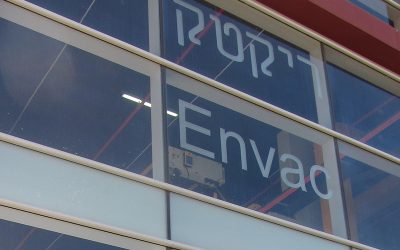Endesa designs a 100% renewable Isla de la Cartuja in 2025
Isla de la Cartuja could become the first European urban environment at the forefront of innovation in renewable energy, sustainable transport, efficient building, open data and digital infrastructure.
16 July 2019
Endesa has delivered today the #eCitySevilla study to the Andalusian Government and the City Council of Seville, a pioneering initiative in Europe to turn the Isla de la Cartuja of Seville into a benchmark of sustainability at an international level and a model of urban energy transition, advancing in 25 years the challenges that the cities of the future will have to face.
In an event held at the headquarters of the Chamber of Commerce of the Torre Sevilla building, the general director of Endesa Andalucía y Extremadura, Francisco Arteaga, presented the study of Endesa #eCitySevilla, a model of urban energy transition, to the councilors of the Andalusian Board of Economy, Knowledge, Business and University, Rogelio Velasco, and Finance, Industry and Energy, Juan Bravo, as well as the mayor of the city, Juan Espadas.
According to this study, prepared by Rafael Sánchez, director of Institutional Relations at Endesa in Andalusia and Extremadura, in 2025 Isla de la Cartuja could enjoy a 100% renewable energy supply, through a photovoltaic generation park and the development of large storage plants In addition, the site would be willing to host parallel actions to turn the entire island of Cartuja into a pioneer energy model worldwide. In this horizon, the study foresees that the space can have an efficient building, after a process of energy rehabilitation of buildings. In addition, it would be the ideal location to deploy charging points for the promotion of sustainable electric mobility.
All of the above elements would create a connected and autonomous system, with shared information, that would work thanks to a fully digitized smart grid (Smart Grid), which would allow an open data platform for intelligent park management.
The proposed actions would turn this space into a socially responsible environment and an international reference in meeting the energy and climate objectives set by the European Union, in the Climate and Sustainable Energy Action Plan, in the 2030 Strategic Plan and in the United Nations Sustainable Urban Development Goals.
The scope of the project would be the entire Cartuja Science and Technology Park and annexed spaces in the surroundings of the Isla de la Cartuja. The PCT Cartuja currently houses 459 companies and entities, which generate direct employment to 17,400 workers and for which it is estimated that around 30,000 people pass by daily.
Endesa has offset the carbon footprint of the development of the presentation act of the #eCitySevilla Study, making it a Carbon Neutral event.
Renewable energy, distributed generation and storage
In terms of energy, the study proposes to carry out the energy supply through renewable energy sources, with more than 30 megawatts of self-consumption and photovoltaic generation facilities produced within the premises, which has almost 2,000 hours of sunshine per year.
The energy production would be sufficient to cover three quarters of the island’s needs (85 gigawatt hours per year) and would reach 100% once the rest of the lines of work analysed in the study were carried out, consisting of improving in a 35% energy efficiency of buildings, through energy audits.
In the advanced phases of the study, it is recommended to incorporate energy storage systems to take advantage of all generation surpluses and provide security and stability to the supply.
Sustainable mobility – 200 charging points for electric vehicles
The study also emphasizes the need to complement these actions with others of sustainable mobility, since the mobility of the future will be electric, connected, shared and autonomous. The initial objective of the proposal proposes the renovation of some 2,000 of the vehicles that circulate through the PCT Cartuja for electric vehicles before 2025, through a plan of priority access to clean vehicles and the installation of at least 200 points of recharge (1 for every 10 electric vehicles), in order to reach a 20% total share of electric vehicles in 2025 and 37% in 2030.
Also, in terms of mobility, the initiative proposes a redesign and greater pedestrianization of the Isla de la Cartuja, prioritizing green spaces and lanes for non-emitting vehicles, recovering 80% of the space now allocated to parking. The study also proposes the advantages of the introduction of new forms of non-polluting public transport, such as shuttles with autonomous driving, in the surroundings of the Island.
Digital infrastructure
In terms of infrastructure, #eCitySevilla requires the development of a smart grid or Smart Grid like the ones Endesa has successfully tested for 10 years in its Smart City Living Lab in Malaga. These networks incorporate a greater degree of automation and control, based on sensing equipment and information technologies, which would facilitate the incorporation of new renewable energy producers, as well as storage systems.
For road lighting, the plan proposes the renovation of lighting on the current public highway, for another one with low consumption (LED), with savings of between 50% and 80%, incorporating sensors that include Internet of things technologies (IoT).
The digital development of the enclosure would also need to enable a platform for the intelligent management of cities, with an open data system model that allows the capture of information, its exchange and its subsequent analysis with advanced technologies.
In the short and medium term, thanks to this platform, services such as street lighting, travel needs, logistics processes, air quality and even connected vehicles for traffic management could be integrated.
459 companies and institutions
The participation of the 459 companies and institutions based in the PCT Cartuja are key in the feasibility of this study, whose development contemplates the possibility of establishing four work groups (energy, transport, building and infrastructure) that would support the execution of the plan, which aims to turn this Park into the first urban environment with 100% renewable energy produced in a distributed way, in a digitalization space that optimizes the use of infrastructure in convergence with sectors such as transport, building and connected objects.
This experience, which would be a pioneer in Europe, would be in a position to be exportable to other places in the Andalusian region such as the Andalusian Technology Park of Malaga, the Health Technology Park of Granada and, in general, all the technological spaces of the community.
This proposal could offer a unique opportunity for Seville, anticipating the future city model, on the one hand, and giving an international projection to its technological capacity and human talent, on the other.
+ Related Posts
Know the advantages of being associated
Smart City Cluster enhances collaboration among its partners, favoring research, development and innovation in the different solutions and technologies aimed at the development of smart cities.
Smart City Cluster is an alliance of private companies and institutions that work for the development of smart cities.



